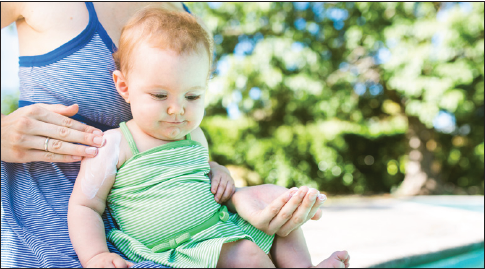Babies—who are especially vulnerable to the damaging effects of ultraviolet (UV)—need vigilant care from their parents to protect them from these dangers. Babies’ skin is thinner than that of an older child, meaning it burns much more easily. According to the Skin Cancer Foundation, research shows that nearly a quarter of infants become sunburned or tanned in their first summer, with more than half getting burned or tanned while they’re still under 2 years old. This can lead to a much higher risk of developing melanoma later in life, since sustaining 5 or more sunburns in youth raises the lifetime risk of this deadly skin cancer by 80%.
Sunburn signs and symptoms
While babies can become sunburned after just 15 minutes of sun exposure, the signs and symptoms may not appear until 6 to 12 hours later. These include:
Red, warm and itchy skin (for mild sunburn)
Widespread burning (for severe sunburn)
Blistered skin
Painful skin
Fever or chills
Nausea
Swollen face
Dehydration
Home treatment for a baby with mild sunburn includes cool baths and putting aloe vera gel or cool compresses on burned areas. But severe sunburn on an infant requires a more emphatic response and is treated like any other serious burn. Call your baby’s pediatrician or get emergency medical care. Babies can end up with grave or even life-threatening problems from too much ultraviolet light. It’s no joke.
Tips to prevent sun damage to your baby
To avoid such consequences, here are tips to stop sun damage in its tracks. These include:
Limiting your baby’s time in the sun between the hours of 10am and 4pm. Better yet, try to keep her/him out of the sun entirely in that time period. This is a simple avoidance technique that works because that’s when the sun’s rays are strongest.
Dressing your baby in a wide-brimmed hat and baby sunglasses (if she/he keeps them on!). Look for sunglasses with 99% UV protection.
Dressing baby in lightweight clothing that covers their arms and legs. More and more clothing is being sold now that offers built-in UV protection, and babies and kids can even take a dip in the pool in these pieces.
Slathering babies over 6 months in sunscreen on all visible skin areas. Buy broad spectrum sunscreen that blocks both UV-A and UV-B light as these are the most damaging rays. The SPF, or sun protection factor, of any sunscreen should be 15 or higher. It is important to know which products you should NOT use on babies’ skin. Avoid sunscreen products with retinyl palmitate or DEET. It’s best not to use an aerosol product, but rather use a cream-based sunscreen you can rub on gently.
Applying sunscreen to baby’s skin at least 30 minutes before heading outdoors, since the sunscreen needs time to soak in.
Reapply sunscreen at least every 2 hours, and more often if baby spends time in the water or sweats profusely.
Sources: Kaleroy Papantoniou, M.D., F.A.A.D. www.advanceddermatologypc.com • www.whattoexpect.com
www.gothink.com
Exclusive content from CARE Magazine








